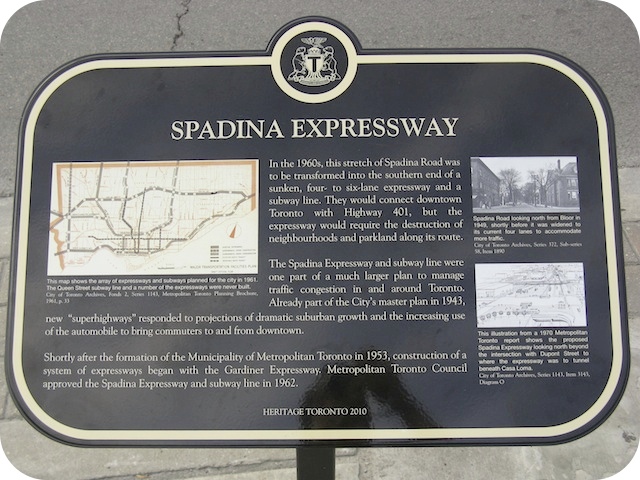Discover Toronto's history as told through its plaques
2004 - Now in our 15th Year - 2019
To see what's new on this site, you can visit the Home Page
Looking at this page on a smartphone?
For best viewing, hold your phone in Landscape mode (Horizontal)
Spadina Expressway

Photo by contributor Wayne Adam - Posted August, 2010

Photo by contributor Wayne Adam - Posted August, 2010

Photo by contributor Wayne Adam - Posted August, 2010

Photo by Alan L Brown - Posted August, 2010
This set of three historical plaques, erected by Heritage Toronto in 2010, is located here at the southeast corner of Spadina Avenue and Bloor Street. A set of three plaques identical to these three can be found further north outside the Dupont Subway Station on the northwest corner of Spadina Avenue and Dupont Street. Here's what they tell us:
Coordinates: 43.666634 -79.403697 |
 |
Spadina Expressway
In the 1960s, this stretch of Spadina Road was to be transformed into the southern end of a sunken, four- to six-lane expressway and a subway line. They would connect downtown Toronto with Highway 401, but the expressway would require the destruction of neighbourhoods and parkland along its route.
The Spadina Expressway and subway line were one part of a much larger plan to manage traffic congestion in and around Toronto. Already part of the City's master plan in 1943, new "superhighways" responded to projections of dramatic suburban growth and the increasing use of the automobile to bring commuters to and from downtown.
Shortly after the formation of the Municipality Metropolitan Toronto in 1953, construction of a system of expressways began with the Gardiner Expressway. Metropolitan Toronto Council approved the Spadina Expressway and subway line in 1962.
"Stop Spadina Save Our City"
For many people, the Spadina Expressway was necessary for Toronto to adapt to modern needs. For others, it promised only the destruction of homes and parks, more traffic congestion, and pollutants from automobile exhaust.
Citizen-led efforts against the expressway grew into the "Stop Spadina Save Our City Coordinating Committee" in 1969. This committee argued that the negative impact of the expressway and its soaring costs were not justified by a faster drive to and from downtown Toronto - itself a short-term gain because increasing traffic from suburban and urban growth would soon overwhelm and clog the expressway. The committee argued instead for better public transit.
The Stop Spadina committee could not convince Metropolitan Toronto Council to cancel the expressway, and then lost a legal challenge in 1970 to cut off funding for its completion. A final appeal to the Government of Ontario, however, was a stunning success. Amidst great controversy, Premier William Davis cancelled the Spadina Expressway on June 3, 1971.
After the Spadina Expressway
The cancellation of the Spadina Expressway in 1971 left a section completed from Wilson Avenue in the north to Lawrence Avenue in the south. Now known as the William R. Allen Road, the expressway was opened to Eglinton Avenue in 1976, while the Spadina subway line was completed along the planned route of the expressway in 1978.
The cancellation of the Spadina Expressway project was a landmark in the development of the City of Toronto. It signalled the end to plans for the other expressways which were to be cut through existing neighbourhoods.
The Stop Spadina movement also helped give a voice to citizens in the planning of their neighbourhoods, and encouraged greater respect for the historic urban fabric during a period of intense redevelopment. Newly elected municipal politicians influenced by the Spadina Expressway fight and other movements of civic activism would shape the City of Toronto in the 1970s.
Related webpages
The Spadina Expressway
The Expressways of Toronto
The Gardiner Expressway
Premier William Davis
The William R. Allen Road
Related Toronto plaque
Spadina Expressway
Norman B. Gash House (Spadina Station Entrance) 1899
More
Transportation
Here are the visitors' comments for this page.
> Posted January 15, 2012
Thank you for taking the time to photograph these plaques. It is interesting to see an example of memorializing something that wasn't created.
Here's where you can send me a comment for this page.
Note: Your email address will be posted at the end of your comment so others can respond to you unless you request otherwise.
Note: Comments are moderated. Yours will appear on this page within 24 hours (usually much sooner).
Note: As soon as I have posted your comment, a reply to your email will be sent informing you.
To send me your comment, click [email protected].
Thanks
Webmaster
Note: If you wish to send me a personal email, click here.